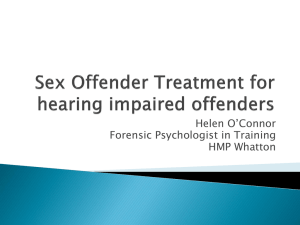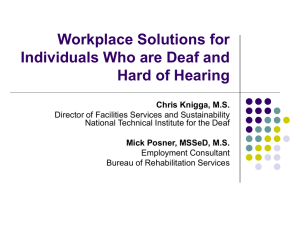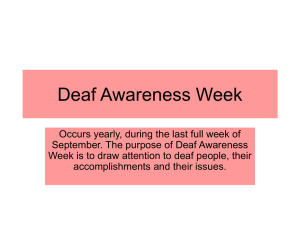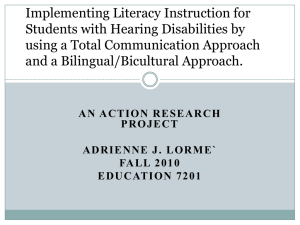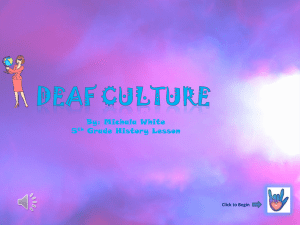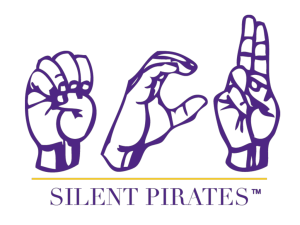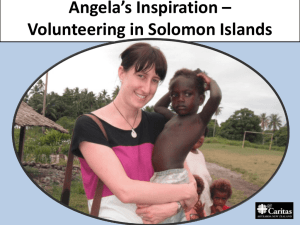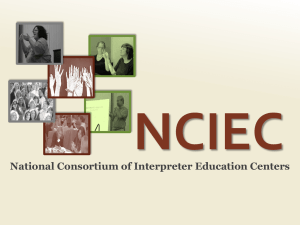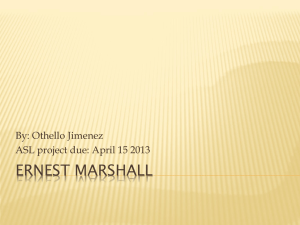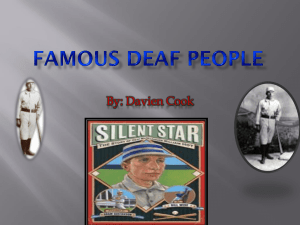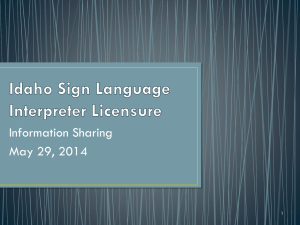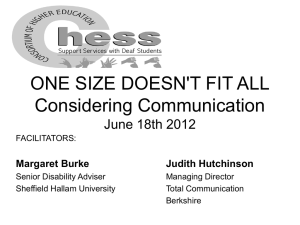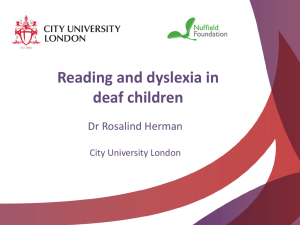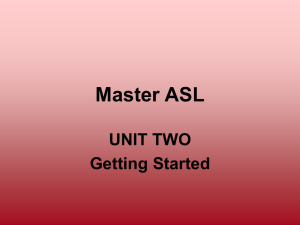Deaf Culture - Nevada Library Association
advertisement
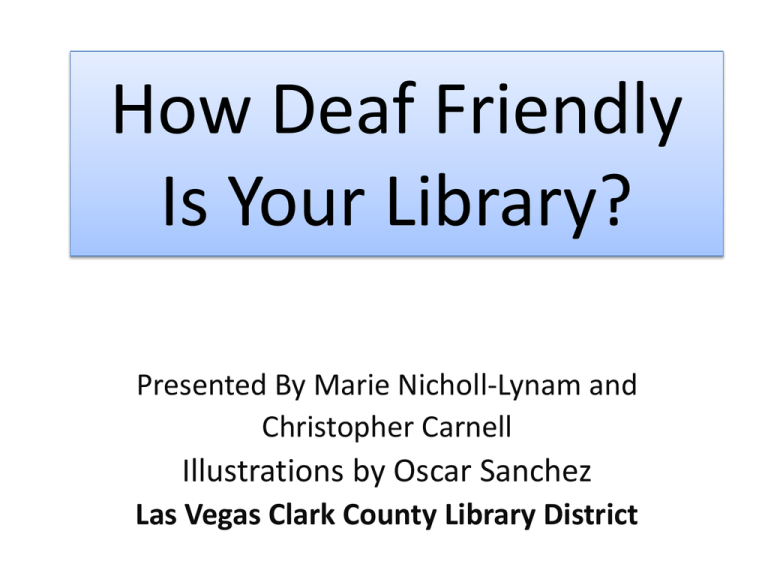
How Deaf Friendly Is Your Library? Presented By Marie Nicholl-Lynam and Christopher Carnell Illustrations by Oscar Sanchez Las Vegas Clark County Library District OUTLINE • • • • • • Terms Deaf Culture/Experience Communication Visual Environment Collection Development Interpreters TERMS deaf: • The physical condition of lacking in the sense of hearing • Being deaf does not make one culturally Deaf. Hard of hearing: • The loss of hearing over time due to age or as the result of an injury in which a lessened capacity for hearing remains. • Tend not to identify themselves as Deaf Deaf: (culturally) • Membership to a group whose identity revolves around deafness, it’s customs, history, values, experiences and the use of sign language. • Deafness not looked upon as a disability but as a different human experience Oralism: The education of the deaf through the use of speech, mimicking mouth movements, and the use of residual hearing and speech reading instead of sign language. Manualism: The education of deaf persons through the use of sign language Total Communication: The concept of utilizing manual, aural and oral modes to ensure effective communication. STAGES OF DEAFNESS Congenitally deaf: Born deaf Adventitiously deaf: Deaf after birth Pre lingual: During the first three years of life Post lingual: After the age of three Child hood deafness: Pre vocational: While a teenager Post vocational: While an adult CAUSES OF DEAFNESS/HEARING LOSS Age: Passage of time Genetics: Several recessive and dominant forms Illness: Measles, Fetal Alcohol Syndrome, Pre-mature Birth Trauma: Head injuries, resulting in tinnitus or damage to the ear itself or aural processing centers of the brain. Noise: Accounts for half of all cases of hearing loss ASL AND OTHER SIGN LANGUAGES American Sign Language (ASL) • A hybrid of Old French Sign Language and Old Kent Sign Language Laurent Clerc (1785-1869) • 1st deaf teacher of the deaf in the United States • Co-founder of the American School for the Deaf At Hartford Connecticut. Vineyarders: • Dialect used in the Chilmark and West Tisbury communities of Martha’s Vineyard, Maryland. • Communities with an high incidence of hereditary deafness. • Old Kentish Sign Language Pidgin Sign • A blend of ASL and Signed English used to facilitate communication between native ASL signers and Native English speakers Signed English • English rendered into sign. • Utilizes English word order and suffixes such as, –ing,-ment,and –ness. • ASL is not universal • There are over 200 distinct , naturallyoccurring sign languages International Sign / Gestuno • Published in 1973 by a World Federation of the Deaf Committee. A collection of approximately 1500 signs. • Used at times at World Federation for the Deaf congress and events such as the Deaflympics. DEAF CULTURE • • • • • • • Residential schools Values and beliefs Clubs Pride Seek out connections with other deaf Etiquette Lip reading (Speech Reading) THINGS TO AVOID The term “Deaf-mute”: Not an accurate term as most deaf have the capacity to speak • Simply choose not to speak because: 1. It is not their primary means of communication • Deaf and dumb: Obvious reasons • Do not refer to a Hard of Hearing person as deaf or a deaf person as Hearing Impaired. ALEXANDER GRAHAM BELL 1847- 1922 • Both his mother and wife were deaf. • Leading advocate for the oralists. • Founder of the American Association to Promote the Teaching of Speech to the Deaf. • Felt the deaf should learn to speak to so they could integrate into the society “Bell believed that deafness was a terrible curse... A pathological aberration [that] perpetuated negative genetic traits… that deaf persons weakened the society in which they lived.” A Place of their Own: Creating the Deaf Community in America John Van Cleve and Barry Couch • Memoir Upon the Formation of a Deaf Variety of the Human Race (1883) • The elimination of residential schools • Forbidding the use of sign language in education of deaf students • Prohibiting deaf adults from teaching deaf children • Proposed legislation against the marriage of congenital deaf mutes • 90% of deaf persons have hearing parents • 90% of deaf persons have hearing children • By 1919 80% of residential day schools had become “oral.” • Deaf teachers became unemployed, forced out of their profession. • Signing and Oral students were segregated • Oral students caught signing were punished • Some children left without any language at all, denied access to sign while being forced to learn to speak SIGN IN NEVADA • There are no schools for the deaf in Nevada. • Las Vegas Charter School for the Deaf closed in March of 2012 due to lack of funding. • There are approximately 550 deaf or hard of hearing students in CCSD that are receiving services. • Self Contained class sizes are approximately 10-11 students each. • Offer both Total Communication and Aural/Oral programs for speech development. NEVADA • Nevada 2008: 77,377 out of 2,568,111 or 3.01% • Nevada 2011: 81,972 out of 2,723,322 • West Virginia 2008: 109,193 out of 1,787,710 or 6.05% COMMUNICATION STRATEGIES COMMUNICATION STRATEGIES • • • • • • Face and lips must be visible Choose a location that is well-lit Avoid standing with your back to any light source Look directly at the person with whom you are talking Avoid distracting background noise Speak naturally - don't exaggerate, shout, or speak too slowly • Use natural facial expressions • Use gestures http://libguides.gallaudet.edu/content.php?pid=352844 DEAF EXPERIENCES IN THE LIBRARY • • • • • Staff has no ASL knowledge/skills Lack of services for the deaf DVDs with captioning are not clearly marked Programs in many languages, but not ASL Treated differently/Overlooked DEAF EXPERIENCES IN THE LIBRARY SEEING THE LIBRARY • • • • • Is the building’s layout intuitive? Are signs direct & easy to understand? Are services/departments clearly marked? Is the building well lit? Is visual clutter a problem? SIGNS AND VISUALS • • • • Clear Concise Thoughtfully placed Free of specialized language or jargon • Pictures or images COLLECTION DEVELOPMENT Thoughtful collection development entails more than buying some sign language books, dvds, & dictionaries… CONSIDERATIONS BEFORE PURCHASE • Currency of information • • • • • • Outdated or pejorative terms Legal, medical, technological Visual quality Author/producer credentials Who is the intended audience? Is it in ASL or Signed Exact English? CONSIDERATIONS FOR A/V MATERIAL • Is it captioned? • Does the packaging indicate captioning? • Know the difference between subtitles & captioning. Subtitles • Word for word • Concept Captioning • Word for word • Denotes speaker(s) • Includes relevant sound effects, noises, music PROFESSIONAL INTERPRETERS • • • • • • Requires formal education & training. Is not merely someone who can sign. Has national or state certification. Adheres to a professional code of conduct. Subject to censure Continuing education. HIRING INTERPRETERS • Determine client’s needs • Budget for interpreters • Where to find an interpreter • • Professional Services NV Dept. of Health & Human Services • Build relationships WORKING WITH AN INTERPRETER • Provide list of client needs • Logistics • • • Lighting Space Cues • Interpreter is there to facilitate • Everything will be interpreted • Interpreting is physically taxing GETTING STARTED • Educate staff • Conquer visual environment • Research & Plan • Collections • Webpage • Events • Look long range • Evaluate REMEMBER Creating a positive library experience for deaf patrons starts with you. QUESTIONS ??? nicholla@lvccld.org carnellc@lvccld.org
